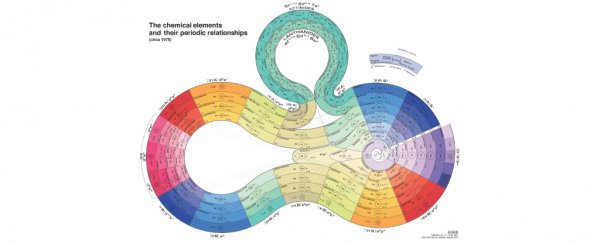In 1869, a Siberian called Dmitri Mendeleev presented a brand new version of the periodic table of elements to his peers at the Russian Chemical Society.
He had tabulated the elements in order of their atomic weight, forming the basis for a fascinating chart that revealed patterns amongst the primary building blocks of matter. It's been 150 years since Mendeleev came up with this idea and created the beginnings of the periodic table as we know it.
But he's not the only person who had a crack at arranging the elements into ways that made deeper sense.
Before Mendeleev, there were a number of scientists who had tried their hand at arranging the 63 elements known at the time.
Since then, scientists have found a total of 118 elements, and there have been many attempts at rearranging them, with charts shaped like anything from weird snails to three-dimensional flowers.
Here are some of our favourites below:
The OG
 (Offnfopt/Wikimedia/Public Domain)
(Offnfopt/Wikimedia/Public Domain)
You know it, you love it, it's the original periodic table. It is arranged by atomic number, electron configuration, and loosely on chemical properties of the elements.
Mendeleev's version of the table had fewer elements than the one above, but he left space for more, and predicted properties of elements that had not yet been discovered.
Amazingly, most of these predictions were proved correct.
The Tower
This table, designed in 2006 by Valery Tsimmerman, grabs Mendeleev's table and throws it out the window (not really, but it's the most different of all the tables on this list).
Instead of being based on atomic numbers, this one - called the ADOMAH periodic table - is systematised around the four quantum numbers of the electron configuration.
These four numbers are used to describe the arrangement and movements of electrons within an atom.
The idea for this was derived from an older table by engineer and biologist Charles Janet. His work rearranged the elements according to orbital filling – basically the likelihood of finding an electron at a particular distance from the nucleus of an atom.
Our favourite bit is that the designer has called the tower "the perfect arrangement of the elements," and even has a sweater featuring the outline of the table on it.
The Spiral
 (DePiep/Wikimedia/CC-BY-3.0)
(DePiep/Wikimedia/CC-BY-3.0)
If the last table was purely functional, this one is mostly looks and design. The spiralling work, created in 1964 by chemist Theodor Benfey, is rather beautiful.
Starting in the middle of the spiral with hydrogen, it swirls outwards in atomic number order before branching off into the transitional metals, lanthanides, actinides, and the currently undiscovered superactinides.
The 3D flower
 (Тимохова Ольга/Wikimedia/CC-BY-3.0)
(Тимохова Ольга/Wikimedia/CC-BY-3.0)
Okay, so this one takes a bit of effort to get your head around, but it's not actually too complicated.
There's no hydrogen or helium on this one. The first, teal-coloured section (or petal) contains the alkali metals on the front, and the alkaline earth metals on the back. Then the other petals contain the rest of the elements, grouped by their elemental qualities.
You can see a moving variation below:

The rainbow ribbon
 (Rezmason/Wikimedia/CC-BY-3.0)
(Rezmason/Wikimedia/CC-BY-3.0)
Called the curled ribbon periodic table, it was created by James Franklin Hyde in 1975.
Hyde was an organosilicon chemist, so he gave silicon the centre stage (in the beige section in the middle of the two circles), highlighting how connected this element is to many others in the table.
But the table still starts in the centre of the right circle with hydrogen, before spiraling out into the different groups. The many colours highlight the elements' periodic relationships.
The beautiful curves put this amongst our favourite options, but it's also pretty intense.
For a practical spin on things, check out this periodic table that tells you how to use those elements.

